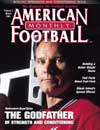AMERICAN FOOTBALL MONTHLY THE #1 RESOURCE FOR FOOTBALL COACHES
Article CategoriesAFM Magazine
|
Spread OffenseA good offense is confusing the defenseHead Coach, University of Rhode Island © More from this issue A GREAT COACH ONCE SAID, "Good football teams either do something different or they do it better." At Rhode Island, we try to do both. The offense we run is a combination of the run and shoot. We call our formation the spread and have found that it allows us to use alignment to stretch a defense both horizontally and vertically. It stretches a defense horizontally with the option and vertically with four quick receivers at the line of scrimmage. This approach, we think, keeps defenses from ganging up on the running game. 
Diagram 1 Here's how it works: The two wide receivers (X and Z on the diagram) line up in the proximity of the numbers, depending on where the ball is. The A-Back lines u....The full article can only be seen by subscribers.
|
|
|||||||
| HOME |
MAGAZINE |
SUBSCRIBE | ONLINE COLUMNISTS | COACHING VIDEOS |
Copyright 2025, AmericanFootballMonthly.com
All Rights Reserved





